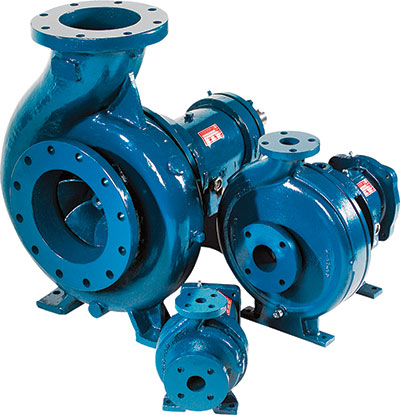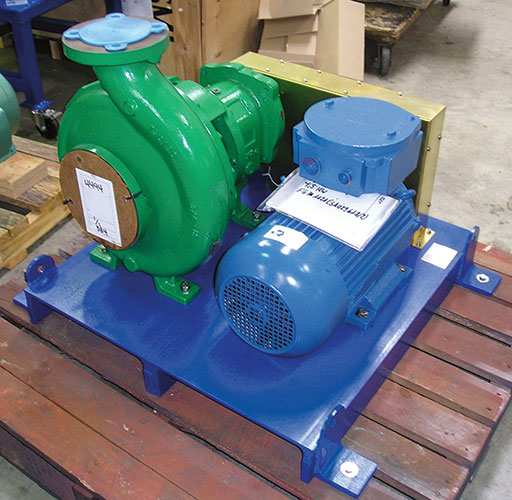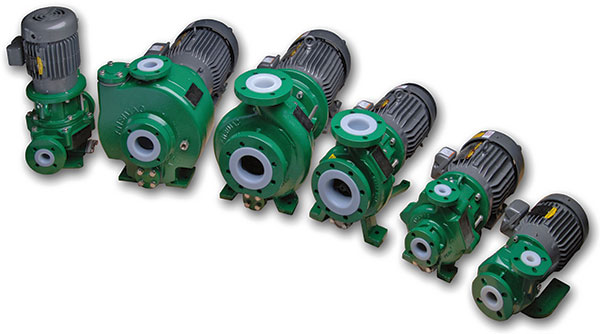Pumps & Systems, March 2013
More than 90 percent of all pumps in many different industries are centrifugal pumps. Variable-speed, large centrifugal pumps are well-known for critical and large pumping services. Centrifugal pumps exhibit a suitable operating curve compared to other pumps (for example, axial pumps and positive displacement pumps offer relatively steep curves). The curve characteristics can be matched with the system requirements. A more backward angle could make a higher reaction (from the pump impeller) and a relatively steeper curve.
As pump stages are put together, the overall flow range of the combined stages could be less than the smallest flow range of the individual stages. Because of the compounding effect, as the flow is changed, the combined curve of a multistage pump could have a smaller operating range. When developing a pump system and before specifying and purchasing a pump, many factors should be considered—including the application, installation, lubrication system, pump operation and pump noise generation. These considerations are discussed in the first part of this article. Part 2 will be in the April 2013 issue of Pumps & Systems.
An example of different pump sizes/models in a pump family. These are sealless, magnet drive, ANSI pumps. Six models are in this family.
Pump Specification and Purchase
The pump operation conditions should be divided into a set of normal conditions and a set of abnormal conditions. The entire anticipated range of operating conditions should be defined either by range limits or alternative operating conditions. Unusual operating conditions, even insignificant ones, should be indicated when developing a list. All available details should be shared with the pump manufacturer. In many cases, insignificant system or environmental conditions can cause considerable problems. Examples could be corrosive traces in the liquid, even if they are in the parts-per-million level.
The purchaser should know as much as possible about the system in which the pump will be installed and the fluid that the pump/system will move and then inform the manufacturer. Particularly, the purchaser should be aware of any unusual conditions and potential upsets that could affect the pump. An example is the liquid temperature runaway potential in some hot liquid units. The pump specification should note all expected maximum temperature values, and the pump vendor should be asked about the maximum temperature that the pump can handle.
Another example is the potential of the sudden dead-heading of a centrifugal pump when switching operations during some batch-type processes. The pump manufacturer should also be informed of any fouling potential. The potential pump conditions should be carefully explored and any fouling potential should be noted. By correctly including the fouling potentials in the description of the system conditions, the pump vendor may be able to include a solution—such as additional head margins—when selecting/manufacturing the best pump for the application.
The pump requisition should include a complete list of the scope of supply and service (preferably in a table format). The pump nozzle orientation is important as well. Ideally, the nozzle orientation details should be agreed upon with the pump manufacturer from the beginning.
Do not assume that the pump vendor is completely knowledgeable about the material requirements for the system/process. Stating the minimum material of construction requirement can help the pump vendor during the pump design/selection phase and avoid future problems. The vendor’s focus is to provide a pump that is compatible with the specifications and reliable enough to cover the vendor’s guarantee period at the minimum possible cost. With the proper wording of the pump specifications, the minimum material requirements can be noted. It can also invite comments that may reveal the vendor’s experience with pump material selection.
A large number of unscheduled shutdowns are traced back to the vendor design; the vendor material selection; or the component selection—such as seal problems, bearing issues, excessive fouling, high degradation, corrosion, erosion and other factors. However, these problems actually reflect a lack of application knowledge, which could have been prevented if the purchaser communicated improper specifications. A good example is the use of austenitic stainless steels, which are normally considered premium materials. However, they cannot be used if chlorides are present in the pumped liquid because of intergranular corrosion and subsequent cracking problems.
The orientation of the inlet piping and its influence on pump performance is important. There should be neither pre-rotation nor anti-rotation. The flow should be free from random distortion. Based on the design, the liquid velocities and the system/process conditions, a minimum length of straight pipe may be required before the pump inlet.
Bid Evaluation for Pumps
A bid evaluation should be made that factors the energy cost, first cost and reliability issues using an established economic equation. If the data are available, the total cost of ownership can be estimated, which is the best available measure for the bid evaluation of a pump. It is absolutely necessary to fix all items and clarify all issues before the pump purchase order placement. Until the vendor is sure he has an order, he will stay in a trading posture.

Figure 1. An example of different pump sizes in a pump family
The successful bidder becomes the vendor when a contract is written and accepted. This is important because the clock has started at this time, and all future dates will be referenced back to this date. This also is the date from which the pump delivery is counted.
Pump Lubrication System
Based on some reports, considerable reductions in the oil flow of the manufactured lubrication oil system can occur compared to the initially-proposed system that was included at the biding stage. The purchaser and vendor have many discussions and debates regarding this issue.
In some cases, the lubrication system’s capacity can be reduced by 20 to 30 percent, occasionally by as much as 40 percent for some large and critical pumps. The proposal technical data (the bid technical details) are not final and some modifications could be expected.
However, an oil flow reduction of more than 25 percent, compared to the purchase order, should not usually occur. Any reduction in excess of 30 percent would require a detailed justification. The vendor should supply the data and the basis for any oil flow reductions that occur, particularly any significant reduction in the oil flow of the hydrodynamic bearings. Sufficient oil supply to the hydrodynamic bearing(s) and the gear units is always a concern.
Pump Installation
How and where the pump/pump system will be installed must also be considered. The prime function of the pump foundation is to hold the pump train in alignment during all operating modes. To perform this function, the foundation should be rigid. Establishing and maintaining the alignment between pump train components—particularly for large pump trains delivered in several skids—is difficult if the foundation is prone to excessive deflections.

Figure 2. An example of a belt-driven ANSI pump—the ANSI pump design can sometimes help overcome issues, such as space restrictions or low NPSH.
The foundation should be large enough to prevent excessive differential deflections and dynamic vibrations, which can have considerable effects on long-term operation. Another aspect is the foundation’s natural frequency. The foundation should be tuned in such a way that any foundation natural frequency is not in coincidence with any of the pump train excitation frequency. It is desirable to have all the foundation’s natural frequencies well above any pump excitation speed, as far above as practical.
Ideally, the pump can be placed on the foundation, aligned and grouted, and piping can be connected according to the pump installation procedure. Lags often occur between different steps. Carelessness can delay start-up and could result in an unsuccessful pump installation. More details on installation will be covered in Part 2 in the April 2013 issue.
Pump Operation
In many cases, the main contributors to centrifugal pump problems are related to the seal, the bearing and rotor dynamics. Long slender rotors can cause problems in centrifugal pumps. Some high-speed pump rotors are subjected to critical speeds, which are encountered during startup (particularly in high-pressure pumps).
Sensitivity to unbalance can also cause operational problems. During operation, as time passes, pumps experience degradation, which usually manifests in ever-increasing levels of unbalance. The more sensitive the rotor, the shorter the runtime.
In many cases, the decision to replace or redesign a pump train component was incorrect. An incorrect diagnosis or wrong interpretation of the reason for a pump failure sometimes results in a solution that appears to fix the problem.
However, if it is incorrect, the solution could possibly lead to worse problems in the future because an incorrect symptom-cause relationship is established. Careful problem solving should accurately determine the real cause of a problem and prevent complications.
The cleanliness of the liquid stream is a key factor, as well, for smooth pump operation and reliability. The corrosive substances and traces require a special material selection and operation considerations. Fouling because of contamination or liquid reaction can cause rapid degradation.
Pump Noise
The overall sound pressure level is generally based on 1 meter from the pump skid’s edge. This means that the sound pressure level of each component at 1 meter from the skid’s edge could be different, usually lower for the large pump packages, than the indicated noise value for each component, which is the noise at 1 meter from that component. The pump package noise is not simply the sum of the noises of different package components.
The gear unit, if used in a pump package, is the major source of noise. For the noise emission of a gear unit, the design of the gear unit has more influence than the transmitted power. A gear unit may generate the same noise or sometimes a slightly higher noise during part-load operation compared to full-load operation. As another example, a 1-megawatt gear unit and a 1.5-megawatt gear unit using the same design principles may generate practically the same noise level.
The pump vendor’s sound calculation programs usually do not simulate any sound boundary condition near the pump package. For example, the boundary conditions (such as a wall close to the pump skid) can influence the noise measured in the plant. Therefore, an allowance is needed to accommodate for this effect. Based on experience, an increase of around 3 to 5 decibels of the expected sound level for a pump package is observed at some unfavorable boundary conditions.
Conclusion
When the pump user and the pump vendor work together as a team and if all the engineers involved give sufficient attention to details, changes and requirements, reliable and high performance pumps can be expected. The keys to success are up-to-date knowledge, correct specifying, proper review of pump vendor documents, correct inspection of vendor activities, and modern operation and maintenance policies. The true profitability and cost savings in a pump installation can only be achieved by combining performance, reliability, safety, availability and maintainability. See the April 2013 issue of Pumps & Systems for more information on installation and alignment.


